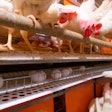
Some signs are emerging in 2023 showing a reduction of losses due to the on-going highly pathogenic avian influenza (HPAI) crisis.
In a WATT Poultry Chat interview, Mark Jordan, executive director of LEAP Market Analytics, reviewed recent data on bird losses to HPAI and compared it with the same period last year. He said losses are slowing down which could show biosecurity measures are working to a degree.
Austin Alonzo: Let's discuss the ongoing, highly pathogenic avian influenza crisis. This week the conversation about vaccination went national with the White House reportedly pressing for nationwide HPAI vaccination. What's the latest with the disease and its impacts?
Mark Jordan: Yeah, absolutely. I think this is something that if you go back, the industry, itself, and everyone who's affiliated with the industry was hoping this would not return as it did from the 2015 version. And even when it did that, it would be very short lived and that's not been the case. We've sort of evolved into a new crisis, one that's ongoing.
I've got a running tally: If you go back to February of last year, look through the first week of March 2023, cumulative losses of commercial poultry here in the US are up over 58 million and still climbing. Cases were fairly active in the fall. Now, the good news is that we've seen a little bit of a slowdown here the last few months. But this is something that's not entirely surprising based on what we know about migratory patterns. We're in a slow period.
But there is something interesting with the data. Looking at the monthly pace of losses. If you look at basically on a year to date basis here in 2023, we've lost not quite 300,000 birds. They've been depopulated to confirmed HPAI. The comparable period last year was about five times that: almost 1.5 million. Now that was skewed a little bit by one large egg laying operation that was hit with over a million birds. There is some encouragement and I think a sense that these all these sectors are having a modicum of success in terms of biosecurity, preventative measures, keeping keeping the virus somewhat in check, but it's obviously still very close.
March and April are the key months where, when you go back to 2015, you go back to last year, this is really the high intensity zone of when cases seem like they're going to be most likely to happen. So certainly looking for a possible spike and anything to keep this thing in check: be it continued enhanced biosecurity vaccines or throwing everything but the kitchen sink at it and maybe even including the kitchen sink to keep it stopped.
One interesting thing: just looking at the numbers and I highlighted the broiler side. This is a little bit of an odd twist, in the sense that the losses so far this year on the broiler side actually make up more than half of the total losses. Over 450,000 broilers lost so far this year, a couple of bigger operate bigger operations hit.
Typically what we've seen, at least last year, going back to 2015, the miniscule portion of the number. So that's that's kind of unique, I don't necessarily think there's too much to make of that just yet. Just kind of shows the turkey and egg industries have been hit so hard, and are now starting to keep the issue a little more in check from from their perspective, which is helpful.
One thing and I'll kind of pivot to this last is trade impacts. Certainly, a lot of times our focus is here on the U.S. maybe North America more broadly. But as most people now are aware this has become a very global issue.
The impact is been sweeping. Europe, Asia, South America and here recently there's been a lot of of issue in South America. This is an odd thing and certainly you don't want to think about it in terms of just capitalizing on others problems, but if the U.S. poultry and egg sectors can keep this somewhat at bay, and this becomes or remains an issue for a little while elsewhere. There's an opportunity there for the U.S. industries to export.
Recent trade data, the January 2023 trade data came in fairly strong. On the broiler side, there was some disjointed export flows early 2022. So I don't know that that last in terms of you will see, you know, see double digit growth this year, but certainly on a positive path this year, and certainly an opportunity, I think, on the export side to fill in some of these gaps elsewhere in the world.
This transcript edited for length and clarity.

















